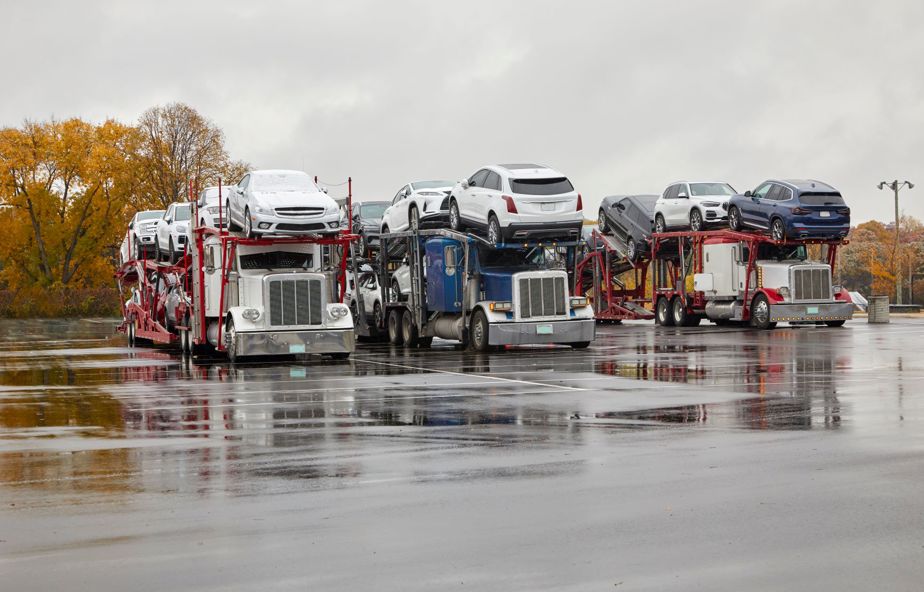We all remember the Lismore floods and the insurance claims they triggered. But one claim that flew under the radar was from one of Australia’s largest independent car carriers.
“They are an important customer; they insure their fleet and equipment with NTI”, said NTI Marine Claims Specialist Kelvin Dias. “They’ve also got a carrier’s policy, which in this case covers damage to the vehicles they’re transporting while in transit.”
“They had trailers loaded with consignments in their yards, ready to be transported to their destinations in the morning. The flood happened overnight, so their yard, the trailers and other vehicles were underwater.”
Kelvin said the claims weren’t too tricky, but getting access to the site to evaluate the damage was.
“At the time, no one could access Lismore – people living there had to evacuate. The yard was underwater; the only vehicles they could save were the ones that were sitting right on the top of the trailers.”
That’s where NTI’s national network of experts swung into action. The floods happened on 28 February 2022. Our insured’s broker contacted NTI the next day, and Kelvin got cracking.
“I got our insureds Director and all the other stakeholders together, including the surveyor and salvage providers. We came up with a plan of action to minimise delays and speed up the settlement process. We knew getting in touch with all the consignees and vehicle owners would be challenging, given the situation.
“Another challenge was to get someone out there because we needed to see the yard and the vehicles to determine the damage and quantify the loss.”
Then Kelvin needed to contact the consignees to see how they wanted to proceed.
“We had to touch base with each and every one of them to make sure they got asked what they wanted to do because some might have wanted to claim on their own insurance. At the time, we didn’t know which parties were retail and which were commercial customers… it was tough.”
Tough, but all in a day’s work for a veteran like Kelvin.
Horses for courses
Kelvin’s been in the insurance industry for about two decades after starting as a plant engineer. “I worked on small semi-automatic pharmaceutical and chemical equipment”, he said, but decided he wanted a change.
“I did some retail insurance to learn the ropes and progressed from there to plant and equipment, and heavy motor. I moved to marine insurance about seven years ago.”
He loves it.
“It’s fascinating, totally different from retail or commercial. You’ve got all these laws and policies across the globe that you need to be in touch with.
“You have to understand how International Cargo Clauses apply, how the NTI policy wording applies, what kind of products, what kind of liability, what kind of risk, what kind of mitigation to take and how that plays out when there’s a claim.
“It’s intriguing – it’s what drew me to marine.”
A day in the life
Kelvin said there’s no such thing as a typical day in the office. “I could have a relatively simple day with just a truck having some goods lost”, he said.
“Or things might be more complex. Maybe a broker calls, and we’ve got a temperature-sensitive cargo in the USA. It’s been out of temperature, it’s worth half a million and we have to get someone out there right away.
“It can be pretty interesting.”
“We need to be honest and transparent from the very start of the claim process”, Kelvin says, noting that there are three steps for resolving a claim:
“First, we need to identify what kind of incident it is and what commodity type it is, so you can start making decisions. If it’s a box of pins, I’m not too worried, even if it’s an expensive consignment.
“But if it’s temperature sensitive, or pharmaceuticals, then every hour makes a difference, and we need to take mitigation steps to minimise the loss or damage. Regardless of the details, we’ll take appropriate action immediately.
“Second, once we know what we’re dealing with, is to appoint the right partner, whether it’s an engineer, a surveyor or an investigator, where we feel it is appropriate to help us expedite the claim. Sometimes, we need someone there to get on the ship, go to the yard, or visit the site. We’ve got partners all over the world that we can appoint when needed. We’ve got everyone in position, so if anything happens, we know exactly who to contact and what to do.
“You have to find out exactly what the cause of loss was and how it happened to ensure we manage the claim properly under the policy. We also want to understand who is responsible for any loss or damage because we want to make sure we’re in a position to recover from all responsible parties.
“Third is to keep the broker or the client updated at every stage as the claim progresses. Once everything’s in place, it’s a waiting game. It’s not like a motor claim, where an assessor inspects the vehicle and says, ‘yes, it’s a total loss’, or ‘it’s going to be repaired’ almost immediately.
“With marine, a few more steps are involved. We get a preliminary report explaining the loss so we can decide what happens next.
“Those decisions mean the surveyor can finalise the report. Then we go back to the broker or customer to let them know exactly what happened, what the losses or policy entitlements are, how the policy will respond and if applicable, proceed to settle the claim.”
Kelvin said it’s tremendously satisfying to settle a claim and help a customer get their business back on track.
“Giving a customer a resolution makes a big difference – it helps them to have clarity, and it’s always satisfying to help someone with their business.”
